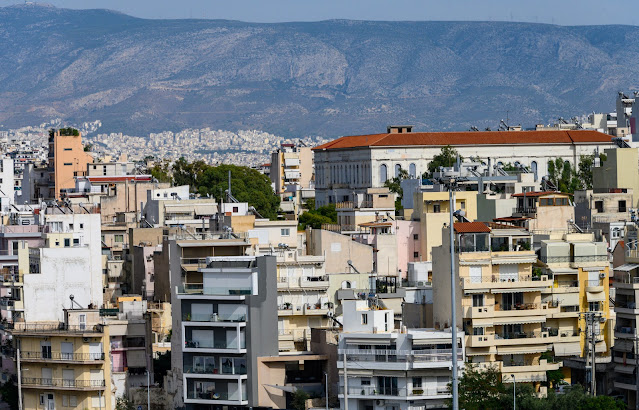It's eight a.m. in the morning and we are already docked in the port of Pireaus.
"Port of Piraeus is the chief sea port of Athens, located on the Saronic Gulf on the western coasts of the Aegean Sea, the largest port in Greece and one of the largest in Europe. "
"The Chinese state-owned COSCO Shipping operate the port." ⬅️⬅️ Just a little more trivia for you trivia buffs.
Nevertheless, by now you have guessed we are in Athens. This is not my first trip here, but it is a first in half a century. What I saw was definitely not what I remembered (imagine that 😉).
First and foremost what stood out was the congestion both in human as well as vehicular traffic. But then again this is a city with ~3.2 million residents and another ~17.4 million tourists ( just in the months of January- August 2023) . Granted we arrived in September, not much had changed as far as tourists.
We chose to forego an excursion and instead visit the city on our own, using a hop on hop off bus and walking the neighborhoods.
We chose not to buy tickets to Acropolis in advance instead we decided to check out the lines and make a final decision then. The decision we made was not to see Acropolis and the temples up close, instead we selected to walk around and admire the sites in the surrounding areas, specifically Dionysiou Areopagitou Street, which is adjacent to the side slope of the Acropolis.
Dionysiou Areopagitou Street, is named after Dionysios Areopagitis, the first member of the ancient court Arios Pagos who converted to Christianity around 50 AD. The street is approximately half a mile long surrounded by both modern and neoclassical luxurious houses, as well as several monuments. It also has one of the best views of of the Acropolis and the ancient temples.
Moving away from Dionysiou Areopagitou Street with its diverse architecture and (numerous embassies as well as prominent people live on this street) into the side streets the view changed a bit.
One of the benifits of hop on hop off bus tours are that you get to see and hear about all the main attractions of a city without exerting yourself.
Unlike many other European capitals, Athens has rather few neoclassical buildings. The largest of them, and one of the most famous landmarks, is the Hellenic Parliament.
"The Hellenic Parliament or “Old Royal Palace” is the first royal palace of modern Greece, completed in 1843. It has housed the Hellenic Parliament since 1934 Bavarian architect, Friedrich von Gartner, designed the palace for King Otto of Greece and his wife, Queen Amalia, with funds donated by Otto’s father, King Ludwig I of Bavaria. Because the building served as a palace for the Greek monarchs for about a century, it is sometimes still referred to as the Old Palace.”
Right in front of the Parliament, a lesser acknowledged monument of Athens is found; the Tomb of the Unknown Soldier. This cenotaph (empty tomb) is dedicated to all the soldiers who fought for Greece. It was constructed in the 1930s, and is guarded by the Evzones, an elite team of young men serving in the military.
A few minutes walk from the Parliament, three prominent architects of the time, Christian Hansen, Theophilos Hansen, and Ernst Ziller, were involved in the design and construction of the Athens Trilogy This wonderful 3-building complex encompasses the University of Athens, the Academy, and the National Library.
There are hundreds of Byzantine churches all around Greece. However, the most iconic one is the Panagia Kapnikarea church. This landmark church was built in the 11th century AD and was dedicated to Panagia, the Virgin Mary. Parts of the church were destroyed during the Ottoman rule. After the Greek revolution in 1821, the church was almost demolished in order to facilitate the construction of Ermou street. Fortunately, it was decided to keep it in place.
The National Archaeological Museum of Athens is the largest archaeological museum in Greece and one of the most important museums in the world devoted to ancient Greek art. It was founded at the end of the 19th century to house and protect antiquities from all over Greece, thus displaying their historical, cultural and artistic value.
" The Zappeion is an important neoclassical building in the National Gardens of Athens. Construction of the building was completed in 1888. It was designed by Danish architect Theophil Freiherr von Hansen.The Zappeion was the first building in the world that was built especially for the Olympic Games. It was used during the 1896 Summer Games as the main fencing hall. A decade after the games, the Zappeion was used as the Olympic Village during the 1906 Intercalated Games. In 1938, the Zappeion became home to Greece’s first national broadcaster, the Athens Radio Station. Historical events including the signing of the documents that formalized Greece’s accession to the European Community in 1979 have taken place in the Zappeion. Today, the building is used for public and private events."
While the tour of all the neoclassical building found in the center of town is over, the tour of the city is definitely not over.
Our destination? One of the oldest neighborhoods in Athens.
In the meantime.....
I believe this would be a perfect place to bring this portion of the tour in Athens to an end.
Our next stop is Monastiraki neighborhood and square.
ραντεβού στο (ranteboú sto)- meet me in
Monastiraki
(source)(source)(source)






















































































0 comments:
Post a Comment